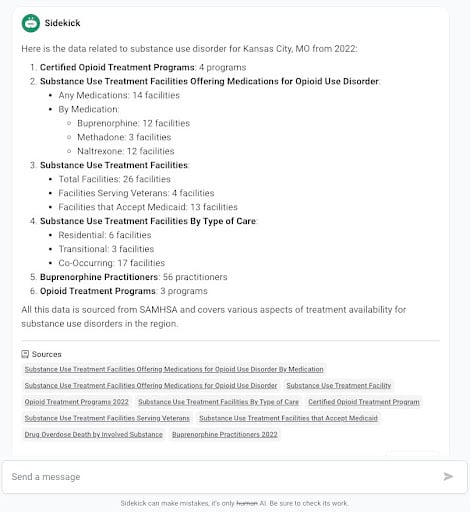AI for Fire: Blazing Trails with New Technology and Tools
mySidewalk’s CRAIG 1300 solution uses the NFPA 1300 Standard on Community Risk Assessment and Community Risk Reduction Plan Development as its framework.
This web-based, dynamic dashboard solution considers the 9 community profiles outlined in NFPA 1300 for inclusion in your department’s CRA and includes hyperlinks to each profile on your dashboard.
These 9 profiles include:
- Demographic
- Geographic
- Building Stock
- Public Safety Response Agencies
- Community Service Organizations
- Hazards
- Economic
- Past Loss / Event History
- and Critical Infrastructure Systems
These 9 profiles, along with retrospective incident data run analysis allow for a comprehensive and holistic overview of community risk.
But what if there was another way to glean similar information about your jurisdiction and community? What if you already have your department’s CRA created and are working on the Community Risk Reduction Plan? What if you’re looking for something particular for a social media post or a grant application? What if you’d simply like to know more about your community?
This is where Sidekick comes in.
An AI-powered Community Data Assistant
Sidekick is mySidewalk’s AI-powered assistant that helps anyone who cares about a place use data to drive community progress. With Sidekick, all of the data and insights you need to make high-impact decisions are instantly within your reach. Designed to amplify the impact of every Changemaker with trusted and transparent analytics, Sidekick elevates the expertise of seasoned data professionals and simplifies data access for everyone.
One of the most important elements for a successful fire service grant application is an understanding of community. Questions like who are those served in your jurisdiction and what are the vulnerabilities these individuals are facing are important questions to find answers for to ensure your grant application rises to the top.
Sidekick can help with this in just a matter of minutes and since it prefers to converse in plain language, fire department grant writers are able to ask Sidekick questions directly from the grant application or the target program.
Here is an example of this in action.
Unlike other LLMs using the internet as its source, Sidekick is pulling data directly from the mySidewalk library so you can be sure to trust the results. And with the ability to export the data to a mySidewalk report or export the raw data or visualization outside the mySidewalk platform, the data is always available and flexible to use.
Leveraging AI-Ready Data to Communicate with the Public
Fire service Public Information Officers will find many benefits with Sidekick as well. Every press release a PIO writes or TV interview held is an opportunity to engage, inform, and educate the public about your community or the risk at hand. Sidekick has your back for quick data grabs related to community information.
Another area where Sidekick can prove beneficial for fire service leaders, risk reduction officers and public educators is the diversity of data it is leveraging. One of the tenets of an effective community risk reduction program is thoughtful and intentional collaboration and for today’s outcomes-based CRR program, data needs to be so much more than just retrospective run data analysis.
With datasets in the mySidewalk library from the Census, CDC, FEMA, BLS, SAMHSA and much more, Sidekick encourages and helps inform those collaborative conversations with the local public health department, police department, homeless shelters, non-profit agencies, hospital systems, other EMS providers and similar agencies working in the social and human services fields.
The issues are too multifaceted for today’s fire department to go it alone.
An increasingly growing trend that has been at the forefront of fire and EMS response and risk reduction efforts for many years now is the work centered on calls for service related to substance use disorder.
These calls, though a vitally important service to the community, can strain a fire department’s resources, tap crew morale, and oftentimes are just as much a public health emergency as they are an emergency services concern.
Understanding the correct questions to find answers for while collaborating with the aforementioned agencies is of paramount importance to reduce calls related to SUDs, help those in need find treatment, and help make your community healthier and safer.
A quick Sidekick query asking for data related to substance use disorder in Kansas City, MO yielded a starting point to have these discussions. See the conversation below:
Ask Sidekick: Please show me data related to substance use disorder in Kansas City, MO.

Sidekick Says: 1) Certified Opioid Treatment Programs, 2) Substance Use Treatment Facilities Offering Medications for Opioid Use Disorder, 3) Substance Use Treatment Facilities, 4) Substance Use Treatment Facilities by Type of Care, 5) Buprenorphine Practitioners, 6) Opioid Treatment Programs
There are myriad challenges facing today’s fire service responders and risk reduction personnel.
The calls the fire service responds to are changing as are the communities they respond to. Fire departments are being asked to do more with less. Understanding the questions to find answers for is a place to start.
You don't have to go it alone. Let Sidekick help you get there.
SEE SIDEKICK IN ACTION
Schedule a Demo
Share this
You May Also Like
These Related Stories
Say hello to Sidekick, your new partner in community transformation
Fast, Relevant Data at Your Fingertips with Sidekick



No Comments Yet
Let us know what you think